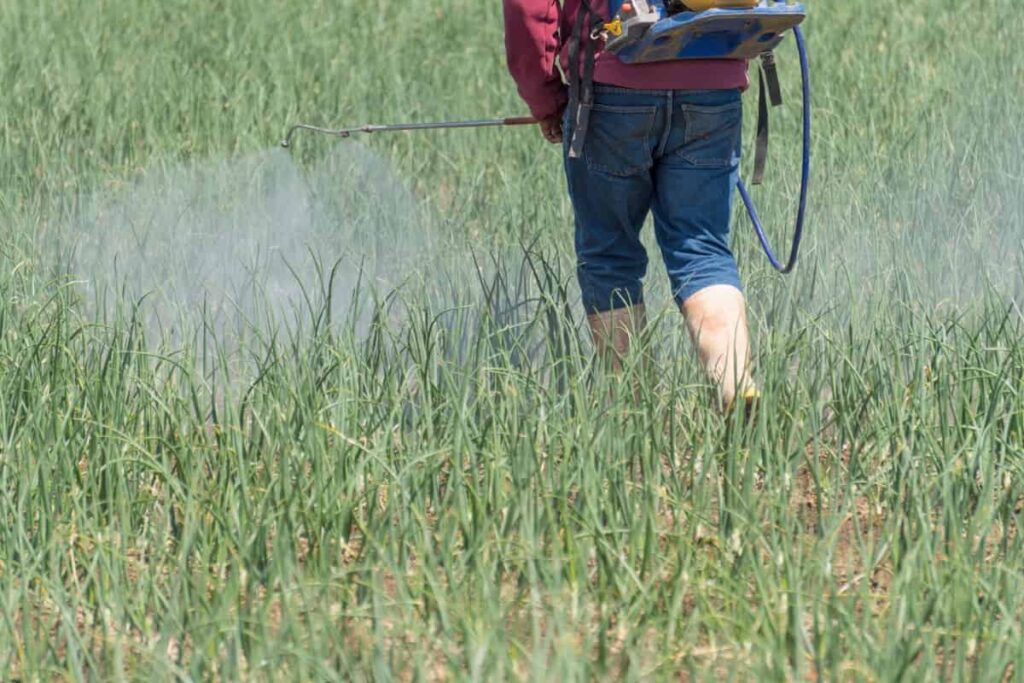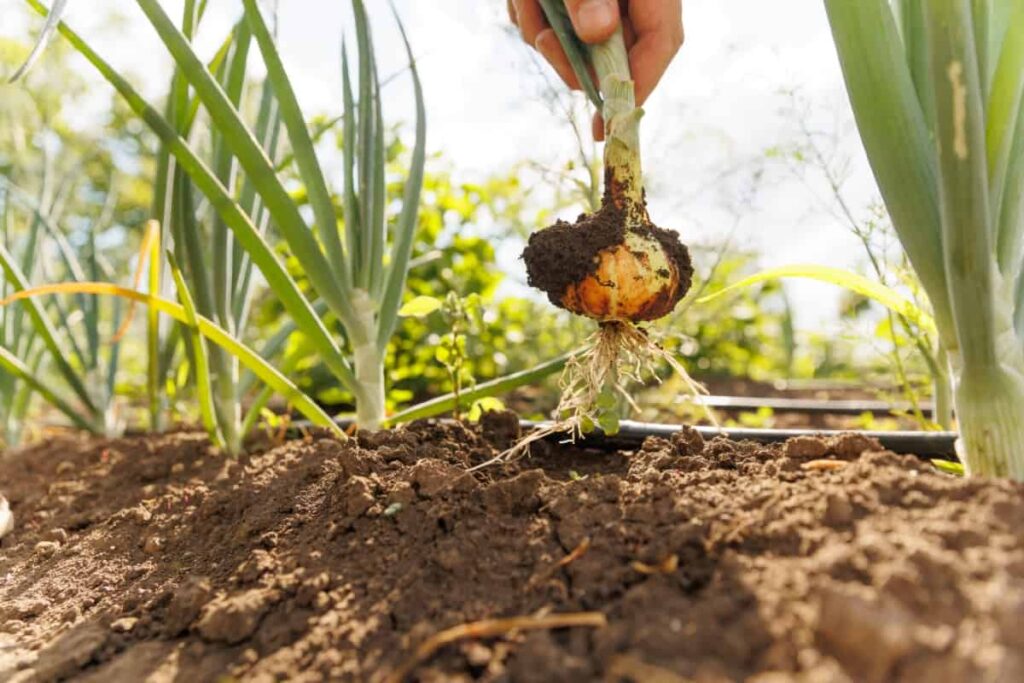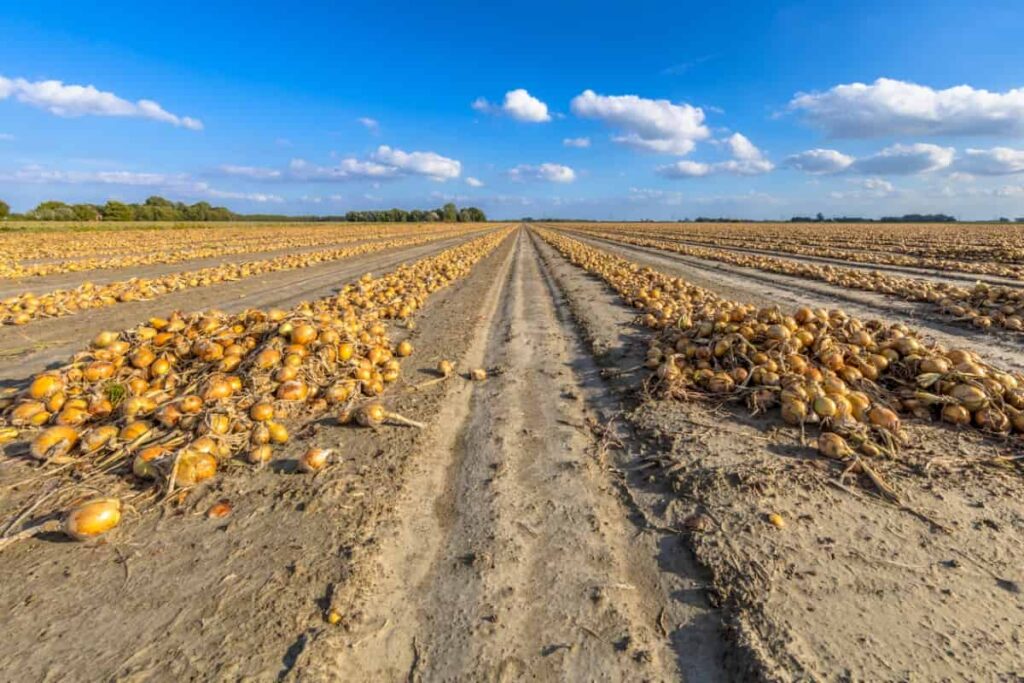This guide provides an in-depth understanding of onion growth fertilizer plans and schedules, covering pre-planting strategies and managing essential nutrients like nitrogen, phosphorus, potassium, and micronutrients. It aims to guide readers on cultivating robust onion crops for successful harvests.

Onion Growth Fertilizer Plan
Introduction to Onion Fertilization
Fertilization is crucial for onion cultivation as onions require a higher amount of nutrients. Fertilizers, which contain essential plant nutrients like nitrogen, phosphorus, potassium, calcium, magnesium, sulfur, iron, zinc, copper, manganese, boron, molybdenum, and chlorine, are applied to the soil or plants to enhance growth and development. The goal is to provide the right amount and balance of nutrients at the right time and form for optimal onion growth, yield, and quality.
Importance of Fertilization in Onion Growth
Onions form bulbs by storing carbohydrates in their leaves and transferring them to their bases, requiring energy and nutrients, especially nitrogen. Bulb size depends on the number and size of leaves, and quality is determined by shape, color, flavor, spice, sweetness, dry matter content, storage life, and disease resistance. Bulb yield depends on factors like onion variety, planting density, irrigation regime, pest and disease management, and fertilization plan. Providing balanced nutrients throughout the growing season increases yield potential.
Basic Nutrient Requirements for Onions
Onions require specific nutrients based on growth stage and environmental conditions. A typical onion crop requires 200 pounds of nitrogen, 80 pounds of phosphorus, and 240 pounds of potassium per acre, according to some sources.
Understanding Soil Nutrition for Onions
Soil nutrition is crucial for onion plants, as it provides water, air, and nutrients. Soil texture, structure, organic matter, and pH are all important factors. Onions prefer well-drained, loamy soil with good water retention and aeration. Soil structure affects pore space, water infiltration, root penetration, and microbial activity.
Organic matter improves soil properties and provides a slow-release source of nutrients. Soil pH alters nutrient availability and plant growth. Onions prefer slightly acidic to neutral soils (6.0-7.0), while too acidic or too alkaline soils limit the availability of essential nutrients.
Soil Testing and Nutrient Analysis
To maximize onion fertilization, a soil test evaluates certain characteristics of the soil, including its texture, structure, organic matter content, pH, CEC, and nutrient levels. Tissue testing determines the nutritional composition of onion plant tissues, which aids in tracking nutrient intake and symptoms of deficiencies. For reliable findings, it is advised to gather soil and tissue samples yourself or to use a professional service.
Adjusting Soil pH for Optimal Onion Growth
Specific recommendations for adjusting soil pH for onions are provided. To lower the pH, sulfur or acid-forming fertilizers like ammonium sulfate or urea can be applied. In contrast, lime or alkaline-forming fertilizers like calcium carbonate or calcium nitrate can be used. Consult a soil test report or extension agent for specific recommendations based on soil type, initial pH, target pH, and application method.
Fertilizer Types Suitable for Onions
There are many types of fertilizers available for onion growers, such as organic or synthetic, granular or liquid, slow-release or fast-acting, etc. The choice of fertilizer depends on several factors, such as your soil type, your onion variety, your climate, your budget, and your personal preference.
Organic vs. Synthetic Fertilizers for Onions
Onions can get a gradual release of nutrients from organic fertilizers, which are made from natural sources such as green and animal manures. They improve soil properties, enhance water-holding capacity, and suppress disease. Synthetic fertilizers, made from chemical compounds, provide a fast-acting, controlled nutrient source for onions, allowing for precise application and control.
Key Nutrients: Nitrogen, Phosphorus, and Potassium
Onions require three main macronutrients for optimal growth: nitrogen (N), phosphorus (P), and potassium (K). N promotes vegetative growth and green leaf production, while P enhances root growth, bulb size, and quality. N should be applied in split doses throughout the growing season, with the last application before the bulb reaches two-thirds of its final size. Phosphorus is crucial for seedling establishment and early root development, while potassium is essential for bulb filling and maturation.
In case you missed it: Growing Stages of Onions and Onion Growth Time Lapse

Fertilization Schedule for Onion Crops
The fertilization schedule for onion crops depends on several factors, such as soil type, plant density, expected yield, and environmental conditions. However, a general fertilization schedule can be summarized as follows.
Pre-planting Fertilization Strategies
To ensure optimal onion growth, conduct a soil test to determine nutrient status and pH. Adjust the pH and apply the appropriate amount of phosphorus and potassium fertilizers. Onions thrive well in slightly acidic soil with a pH of 6.0 to 6.8, and lime or sulfur can be used if it is too acidic or alkaline. Apply phosphorus and potassium fertilizers at least three inches below the seed or transplant row to avoid root injury and ensure nutrient availability.
Growth Stage-Based Fertilization
The growth stages of onion crops are divided into four phases: vegetative growth, bulbing initiation, bulb development, and bulb maturation. During vegetative growth, onions require a lot of nitrogen for green leaves and strong stems. Bulbing initiation occurs when the onion plant starts to form a bulb at the base of the stem, requiring less nitrogen but more phosphorus and potassium. Bulb development occurs from bulbing initiation until bulb maturation, requiring a balanced supply of N-P-K fertilizers. Bulb maturation occurs when the bulb reaches its final size and shape.
Nitrogen Management in Onions
Nitrogen is crucial for onion growth, impacting bulb yield, size, and quality. However, onion management is challenging due to shallow root systems and low nutrient efficiency. Proper nitrogen application is essential for optimal production.
Role of Nitrogen in Onion Development
Nitrogen is crucial in onion development, playing a role in photosynthesis, protein synthesis, and disease resistance. It is present in chlorophyll, the green pigment that converts light energy into chemical energy. Deficiency can reduce photosynthetic rate and carbohydrate production, while protein content and quality can be reduced. Additionally, nitrogen can affect disease resistance and storage life.
Timing and Application Rates for Nitrogen
Nitrogen application timing and rates depend on factors like soil type, plant density, expected yield, and environmental conditions. A general guideline is to apply 30-40 pounds of nitrogen per acre for pre-planting, 30-40 pounds for vegetative growth, and 15-20 pounds for bulb development, and stop when the bulb reaches two-thirds of its size to prevent excessive growth and improve storage quality.
Phosphorus and Potassium in Onion Cultivation
Phosphorus and potassium are also important nutrients for onion cultivation, as they enhance root growth, bulb size, and quality. Phosphorus is especially important for seedling establishment and early root development, while potassium is crucial for bulb filling and maturation.
Importance of Phosphorus and Potassium
Onion development relies on the presence of Phosphorus and potassium in the root system. Phosphorus stimulates root growth, enhancing water and nutrient absorption, thereby improving onion yield and quality. It also aids in bulb size, synthesis, and quality, affecting color, flavor, spice, dry matter content, and storage life of onion bulbs.
Application Techniques and Timing
P and K are important for plant growth, with pre-planting rates ranging from 100-200 pounds per acre. These nutrients are crucial for seedling establishment and root development. Vegetative growth requires no additional phosphorus or potassium, while bulb development requires 25% more phosphorus and potassium than pre-planting rates every two to three weeks. Bulb maturation requires no additional phosphorus or potassium.
Micronutrients and Onion Health
Micronutrients are crucial for onion plant development, supporting physiological processes like photosynthesis, enzyme activity, cell division, root formation, and bulb formation. Inadequate micronutrients can cause stunted growth, leaf curling, poor bulb development, and reduced yield.
Identifying Micronutrient Needs
To identify micronutrient needs in your onion crop, test soil and plant samples for pH, organic matter content, CEC, and nutrient availability. Comparing soil and plant test results can help identify deficiencies or imbalances, allowing you to adjust your fertilizer plan accordingly. Soil samples and plant tissue samples can be sent to a testing laboratory for analysis.
Effective Micronutrient Application Methods
- Soil application involves mixing micronutrient products with major fertilizer products or applying them separately.
- Foliar application involves applying liquid or soluble forms to onion leaves using sprayers or watering cans.
- Fertigation involves applying micronutrients through irrigation systems, delivering nutrients uniformly to the root zone of onion plants.
Organic Fertilization Options
Organic fertilizers, derived from organic sources like plant, animal, or mineral sources, offer benefits like improved soil structure, increased organic matter, enhanced fertility, reduced erosion, and support for soil biodiversity, all while reducing pollution.
Utilizing Compost and Manure
Compost and manure are beneficial for onions, providing organic matter and nutrients. They improve soil structure, water retention, drainage, aeration, microbial activity, and nutrient availability. Compost and manure can be used as soil amendments or fertilizers, but timing, amount, and type should be considered.
Organic Liquid Fertilizers and Foliar Feeds
Foliar feeds and liquid fertilizers, made from natural substances like fish emulsion and humic acid, are effective in providing nutrients to onions, supplementing soil, and enhancing their uptake by roots and leaves, as well as enhancing their nutritional value.
In case you missed it: Onion Farming in Tamilnadu: A Helpful Production Guide for Beginners

Monitoring and Adjusting Fertilization
Onion plants require adequate and balanced fertilization to produce high yields and quality bulbs. The main nutrients that onions need are N, P, and K, as well as some micronutrients such as zinc and sulfur. The fertilizer program for onion crops should be based on soil test results, crop growth stage, and environmental conditions.
Assessing Onion Plant Health
Monitoring onion plant nutrient status involves observing growth and appearance. Healthy plants have dark green leaves, vigorous roots, and uniform bulb development. Signs of nutrient deficiency include.
- Pale green or yellow leaves.
- Poor root growth.
- Yellow or brown leaf margins.
- Reduced bulb size and quality.
- Light green leaves.
Adjusting Fertilization Mid-Season
Fertilizer application for onion plants may need adjustments based on soil test results and plant health assessment. Guidelines include applying nitrogen fertilizer every 2-3 weeks until the neck softens, phosphorus fertilizer near roots, potassium fertilizer for bulb size and quality, zinc fertilizer for enzyme activity and photosynthesis, and sulfur fertilizer for flavor and spice. Avoid excessive nitrogen to avoid delays in bulb formation and storage.
In case you missed it: Onion Farming Information Guide for Beginners

Conclusion
The onion cultivation journey requires a balance of science and care. Our plan and schedule provide knowledge on nurturing thriving onion crops, including selecting appropriate fertilizers and adjusting plans based on plant health. This guide ensures a fruitful and sustainable harvest, ensuring abundance, flavor, and nutritional goodness in onion fields.
- Management Pests and Diseases in Your Cotton Field
- Sheep Farming Business Plan for Beginners
- Aquaponic Farming at Home: A Step-By-Step Guide
- Profitable Village Farming Business Ideas in 2024
- High-Yield Aquaculture: Fast-Growing Fish for Farming
- Effective Fish Pond Construction Techniques for Beginners
- Irrigation and Water Management in Pineapple Farming
- Blossom to Harvest: Mastering Flowering and Pollination in Papaya Farming
- Pig Fattening Essentials: From Selection to Sale for Beginners
